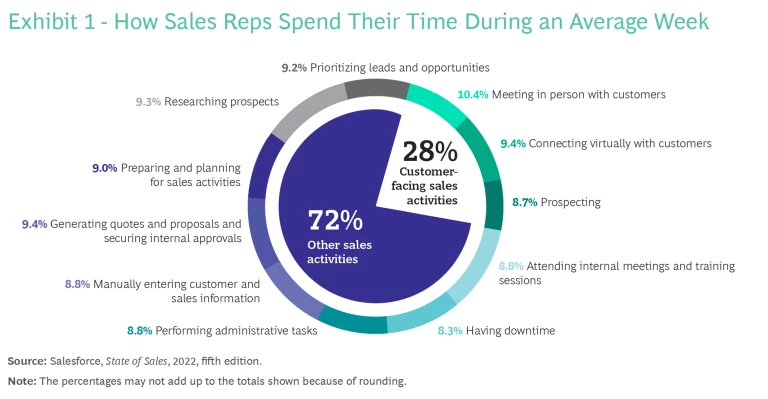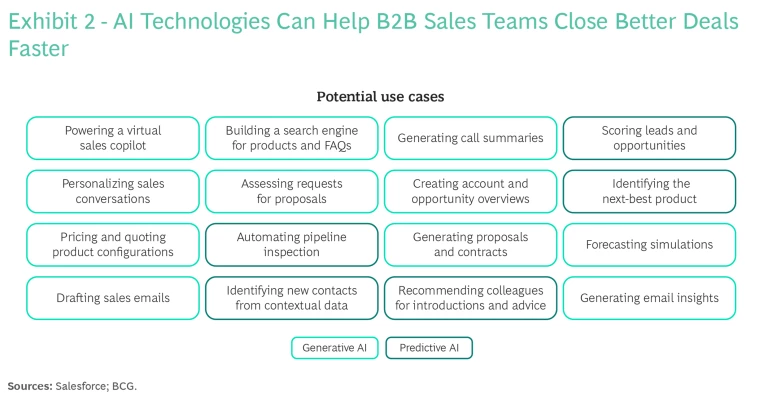For telecom companies, the excitement around generative AI isn’t quite at Swiftie levels, but it’s getting close, and here’s a reason: GenAI promises to put the sales back in sales teams. This is especially appealing to the B2B sector, where sales representatives spend the bulk of their time—72%, according to a study by Salesforce—on tasks other than selling. (See Exhibit 1.) The beauty of GenAI is not only that it lets sales reps spend more time with prospects and customers but also that it makes those interactions more personal and more productive than ever before.

So, how can telcos go about adopting and scaling GenAI? This is where many telcos run into challenges—and out of steam. They launch proofs of concept yet struggle to turn potential into value. The catch is that GenAI doesn’t work in a vacuum. Maximizing its impact means taking an integrated approach—one where GenAI (algorithms that can create original content) works hand in hand with more traditional predictive AI (models that can forecast outcomes, results, or trends), while blending in the knowledge and skills of a telco’s sales teams.
The integrated approach is also a broad approach. AI leaders—companies that successfully use AI, whatever its form—think relentlessly about data, technology, processes, and people. They consider risks and establish governance and trust. And crucially, they fit all these pieces together just right. Then, the rewards are just right, too. For example, organizations that fully harness the power of generative and predictive AI—creating effective end-to-end sales processes—have the potential to boost EBITDA by more than 40%, through top-line growth and bottom-line efficiencies.
Attaining such rewards is a journey, but it doesn’t have to be an arduous one. BCG and Salesforce have partnered to create an integrated GenAI strategy. It’s a gradual approach that enables telcos to deliver quick wins and build on that success, while steadily developing their capabilities, optimizing AI-human collaboration, and, ultimately, transforming B2B sales.
Transformation in Three Phases
Across industries, AI—in both its generative and predictive forms—is a powerful catalyst for operational efficiency, enhanced customer experiences, and growth. But for the telecom sector, its reach is particularly broad, turbocharging all aspects of the business, including marketing, support, and network optimization. To spotlight the ground that GenAI and predictive AI cover in B2B sales, BCG and Salesforce have developed a set of use cases. (See Exhibit 2.) It’s not an exhaustive list, and many more use cases will come, but it underscores the power of AI technologies to simplify, automate, and propel an array of processes and interactions.

By themselves, these use cases bring significant value. For example, GenAI’s ability to create content—such as call summaries—lets telcos automate many of the tasks that keep sales teams from doing what they do best: interacting with prospects and customers. But the real power—and payoff—is apparent when GenAI, predictive AI, and human capabilities all come together.
Consider, for instance, the request for proposal (RFP) qualification process. Success rates—and revenue—depend on how effectively and efficiently B2B sales teams respond to RFPs. So, to help these teams, Salesforce configured and piloted a use case that combines GenAI and predictive AI to read and qualify RFPs and even fill them out. That’s just one example; the array of hybrid use cases is limited only by the imagination. Another scenario is helping sales teams with cross-selling. Predictive AI could identify cross-selling opportunities and dynamically price the relevant offering, zeroing in on the right buyer and the right price. It could then feed that information to a sales rep, with GenAI creating, on the fly, product material, customer profiles, and talking points to help the rep close the deal.
Stay ahead with BCG insights on artificial intelligence
While such use cases will spark more potential—and inevitably, more excitement—than task-level automation, they’re also more difficult to implement. They require greater AI maturity and deeper, more carefully orchestrated links among technologies, processes, and people. This is why we see a phased approach as the best way to implement GenAI. Start small, generate value early on, and leverage the momentum from that win to keep going—steadily increasing capabilities, integration, and value.
A phased approach also addresses another key point: different telcos are at different starting points in their GenAI journey. So, while many companies will start at the beginning, others can skip to a more advanced stage.
In all, we see a GenAI-fueled transformation of telcos’ B2B sales consisting of three phases:
- Task Automation and Augmentation. The idea here is to deploy GenAI tools to simplify or even assume many of the day-to-day tasks, such as updating records in a customer relationship management system and creating sales call summaries, that bog down sales teams. Many of these capabilities can be launched out of the box, reducing entry barriers and giving telcos a fast on-ramp to a GenAI transformation.
- Reimagined Individual Workflows. In this phase, telcos integrate GenAI into the workflows and processes of sales teams. Automation extends beyond task-level activities to more complex needs, including generating RFP responses, quote updates, and approval triggers. Reimagined and infused with GenAI, end-to-end processes take less time to complete—increasing, in one fell swoop, the productivity of an entire team.
- Transformational Change. This final phase represents a fundamental shift in telcos’ go-to-market strategy. Using predictive AI and GenAI, telcos interact with their customers in completely new ways, such as through an intelligent sales agent—an AI-powered tool that engages with prospects and customers, analyzing their questions to determine what to do next, whether it’s providing product information, for example, or scheduling a sales meeting. But to seize the full potential, telcos must adopt new ways of working and undertake a complete redesign of processes that span different departments. Success also means orchestrating across solutions in telcos’ architectural landscape. The idea is to connect the business support systems (that help sales reps) with the operational support systems (that power operational processes) in such a way that telcos reduce the manual work back-office teams perform.
In this way, a journey that starts small ends big: sales processes run at hyperspeed, sales teams move their focus back to sales, and customer interactions become richer, smarter, and more impactful.
Best Practices for Success
A key reason companies stall amid a GenAI transformation is that they underestimate—greatly—the change effort required. However, winning with GenAI means remembering the key tenet of AI transformations: organizations need to get the algorithms and technology right, but they also need to rethink processes and empower people.
GenAI leaders understand that the bulk of their work needs to focus on enablement: fostering adoption at scale, reimagining business flows and ways of working, and creating a culture that stresses, values, and facilitates human-AI interaction. By using what we call the 10/20/70 rule—devoting 10% of the effort to algorithms, 20% to data and the technology backbone, and 70% to processes and people—organizations can succeed with a GenAI transformation.
Within these buckets, steps vary, depending on an organization’s circumstances, capabilities, and culture. We’ve found, however, that in all cases, the following best practices can guide the way. Together, they drive the integration—of algorithms, data and technology, processes, and people—that is the heart and lifeblood of AI and GenAI transformations alike.
- Set the top-down vision and ambition. What is the aspiration for a GenAI-powered sales organization? The specifics will differ from one telco to another, but a common thread is a focus on a human-centered AI approach: creating systems that amplify and augment—rather than displace—human capabilities. The sponsorship and buy-in of company leaders are critical and should be visible across the organization, so as to foster momentum for change and adoption.
- Define clear business outcomes. Identify and communicate exactly how GenAI can create value for the organization. In zeroing in on these outcomes, stress simplification. The goal is to create intuitive, consistent, and seamless experiences for customers, employees, and partners.
- Identify use cases that can drive the target outcomes. What combination of predictive AI and GenAI maximizes impact? Do available models suffice, or should you build or buy something new? In answering that last question, consider the cost and effort, but even more important, think about the fit: What solution is best suited for seizing the full potential that the use case presents?
- Determine how the tech stack stacks up. Baseline the current technology landscape. What additional capabilities does the company need to support the preferred GenAI use cases? How difficult will it be to add or develop these capabilities? Can they be deployed without interfering with existing applications? Answering these questions helps gauge the feasibility of potential use cases.
- Choose a lighthouse use case. No two use cases—even those at the top of the wish list—will deliver the same value at the same speed with the same effort. A lighthouse use case demonstrates, visibly and early on, the value that GenAI can bring. It’s a quick win that sparks momentum for the longer journey. The best candidate, then, will be the use case that offers the best balance of value and feasibility.
- Build trust into the flow of work. GenAI models typically train on huge volumes of unstructured data, such as documents, images, audio and video files, and even programming code. Many organizations worry about how the models will use that data down the road. Will they inadvertently divulge customer or other sensitive data? Will they provide responses that let others—perhaps competitors—infer such information? Technology can raise questions around risk, but on the flip slide, it can also promote trust. That’s the objective of privacy and security implementations, such as Salesforce’s Einstein Trust Layer—a set of agreements, security technology, and data and privacy controls used to keep data safe while exploring GenAI solutions on the Salesforce platform. Features include data masking, zero retention, secure data retrieval, and an audit trail.
- Drive rapid organizational change while nurturing a sense of opportunity. A GenAI transformation isn’t a journey only for a company. It’s a journey for every individual and every team within the organization. So, ask how leaders can support people along the way and incentivize adoption. The key is to develop a robust change management strategy. Culture, training, upskilling, coaching, centers of excellence—all are core components. Keep the focus on usability and track adoption. The ability to make quick, responsive adjustments helps drive change—and crucially, sustain it.
Telecom B2B sales teams have a lot to gain from GenAI. So do their customers. But it takes more than great algorithms to succeed. Getting GenAI right—and getting better, faster, and richer experiences on both sides of the sale—requires a holistic perspective and a phased approach. Step by step, use case by use case, the pieces come together, and the value grows.
The authors wish to thank Alfonso Abella, Phillip Andersen, Ignacio Hafner, and Basir Mustaghni at BCG, as well as Meredith Alexander, Jonathan Phillips, and Alexa Vignone at Salesforce, for their contributions to this article.






